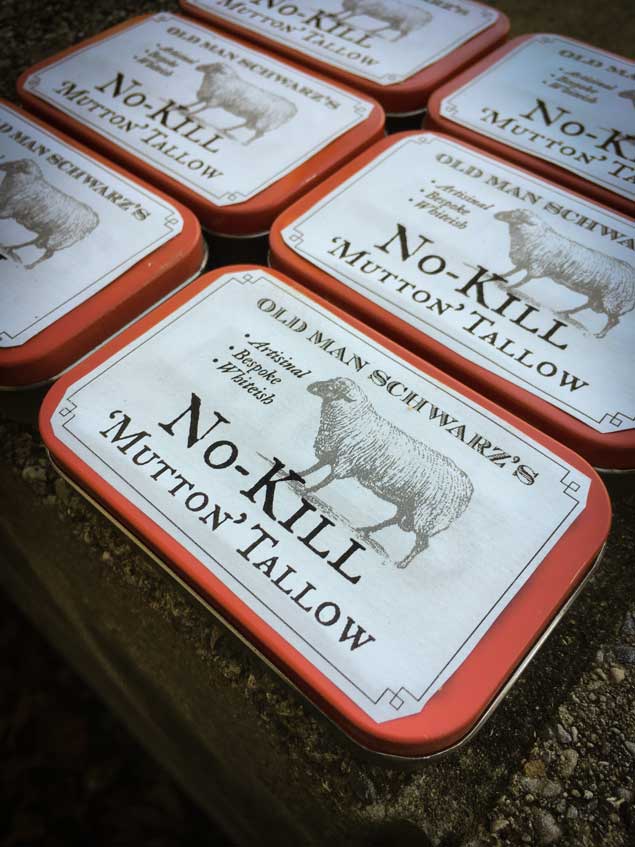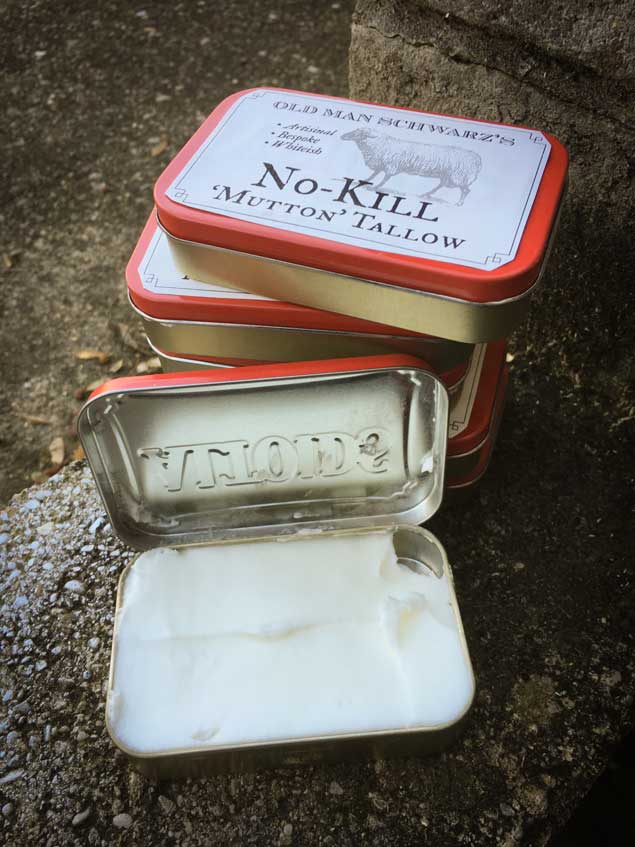We may receive a commission when you use our affiliate links. However, this does not impact our recommendations.
 Hand-tool woodworkers love mutton tallow as a lubricant for saws, auger bits and the soles of our handplanes. A smidge of the stuff will make your tool slide easier – and your shop will smell like lambchops.
Hand-tool woodworkers love mutton tallow as a lubricant for saws, auger bits and the soles of our handplanes. A smidge of the stuff will make your tool slide easier – and your shop will smell like lambchops.
But because of animal-rights concerns, mutton tallow is shunned by some woodworkers. (They already shun paraffin because it is made by Big Oil.) In 2016, a start-up corporation tried to make mutton tallow using fat that had been removed from sheep via liposuction, but the cost was prohibitive ($20 for 4 oz.!).
 I offer this simple solution: Old Man Schwarz’s No Kill ‘Mutton’ Tallow. It’s made entirely from vegetables, which don’t usually scream when you kill them. It comes in a tin, just like mutton tallow. And it works exactly the same, except you aren’t haunted by the souls of sheep who lubricated the soles of your planes.
I offer this simple solution: Old Man Schwarz’s No Kill ‘Mutton’ Tallow. It’s made entirely from vegetables, which don’t usually scream when you kill them. It comes in a tin, just like mutton tallow. And it works exactly the same, except you aren’t haunted by the souls of sheep who lubricated the soles of your planes.
You can’t buy it. But you can make your own.
Buy some Altoids. Eat them (or give them to Megan; it’s her superpower). Buy a can of Crisco vegetable shortening (made right here in Cincinnati!). Print out this pdf of the labels.
Cut out the labels. Spray on some adhesive to the backside of the labels. Stick the labels to the tins. Fill the tins with Crisco.
And voila. All the lubrication with none of the guilt.
— Christopher Schwarz
- To read past entries from this guide (and from former years), click here.
Here are some supplies and tools we find essential in our everyday work around the shop. We may receive a commission from sales referred by our links; however, we have carefully selected these products for their usefulness and quality.









I presume that tallow/”tallow” will work just as well as a lubricant for driving screws… (Brass screws can use all the help they can get, even when you pre-tap with steel screws.)
Someone above mentioned using tallow as an end-grain sealer… I know that if you use enough to interfere with finishing you’ve probably used far too much, but does tallow and/or veg shortening seal grain in the same way shellac does (though it’s non-drying), less so, more so….
(Shortening. That’s what you apply when the piece is just a bit too long, right?)
I still have Crisco on the kitchen shelf from a pie crust attempt a decade ago. I think you may have given me the excuse I need to move it elsewhere, even if I’m too much of a pack rat to just throw it out.
Just because we can’t here it, doesn’t mean the plants don’t scream when they die, lol.
“… souls of sheep who lubricated the soles of your planes.” That was glorious.
Camellia oil is wonderful also. Lubricates tools and feel great on your hands. I’m told it’s used in cosmetics.
Me thinks that in your bid to move in on the territory of Koch Industries as a new billionaire, you realized that you actually needed all those darn sheep to supply sheep-power to the machinery of your tallow factory — killing your “engines” just wouldn’t work! Now you pander the “No-Kill” aspect as if you are actually proud of the fact that you have 25 displaced and very sad sheep chained up in your backyard, endlessly walking a sheep treadmill in order to make you into a so-called Mutton Tallow Magnate.
Yes “Old Man,” you’re on your way to fortune with your whiz-bang lube that is “artisanal” AND “bespoke.” Now, be gone and go sit in that dugout throne of yours, which you no doubt created in anticipation of being able to sit and lord over your inhumane tallow factory!
Oil rag in a can,fancy exotic oils and simple 3 in 1 but Crisco is a game changer because it also comes in butter flavor. Yum butter.
So if its true that some people refuse to use mutton tallow or parafin wax because of its evil source, then they better be using only deadfall trees for their projects. And even at that, they are probably destroying the homes of some little woodland criiters.
And they sure better stop using any steel or other metal cutting tools, and just use flint tools, because you can’t make steel without coal, for both metallurgical reasons and to produce all the energy needed to produce it (or nuclear energy, gaia forbid, or even hydro-electric which destroy fish migration. And add to that all the acids for pickling, oils for cutting and milling.
And I was expecting Mr Schwarz to announce that he has opened a liposuction clinic for sheep. Or opening a farm for sheep with prosthetic legs. There’s getting to be too much political correctness and not enough snarkiness here.
Beef and Mutton Tallow
Tallow is rendered beef or lamb fat. Make your own. It is a worthy task, not that difficult and is the best end grain wood sealer there is. Ask the butcher for beef or lamb trimmings. Physically remove as much meat and other non-fat matter as possible. Cook it in water just hot enough to melt the fat. Add alum that coagulates remaining foreign matter that will rise to the surface of the cooling fat. When the fat has cooled, scrape off and discard all coagulated impurities. Repeat the process to increase tallow purity and shelf life. Pour off the water. Store tallow in a covered glass or plastic container at room temperature. I have kept the same fully useable tallow in my shop for 30 years. It hardens, seals and lubricates upon application. It has no smell to speak of.
As a post and rung chair maker and greewoodworker, I it use tallow, among many other things, to:
coat end grain of tool handles
to lubricate wooden plane soles
to coat all end grain of pith centered green wood clubs during construction
lubricate wood while being threaded
I was certain you had a herd of 3 legged sheep somewhere.
“Cheeky Genius”
In England Crisco it available on eBay at a fair old cost. I hate the smell of it and of mutton fat. Beef fat or “dripping” makes a great spread on bread. I much prefer candle-wax that I get free from my Church or beeswax dissolved in some distilled (pure) turpentine and put into a tight tin. If I am lucky the candles may be near 100% beeswax
Better put it on your plane sole than in your stomach!
First of all: you’re a cheeky bugger (which I’m sure you already knew!)
Second: Are you serious about using mutton tallow? What benefit does it give over a similar viscosity paste wax (apart from the chop smell)?
PS “cheeky bugger” used to be Australian Indigineous pidgin for a stinging insect. It’s probably even more appropriate with that knowledge 🙂